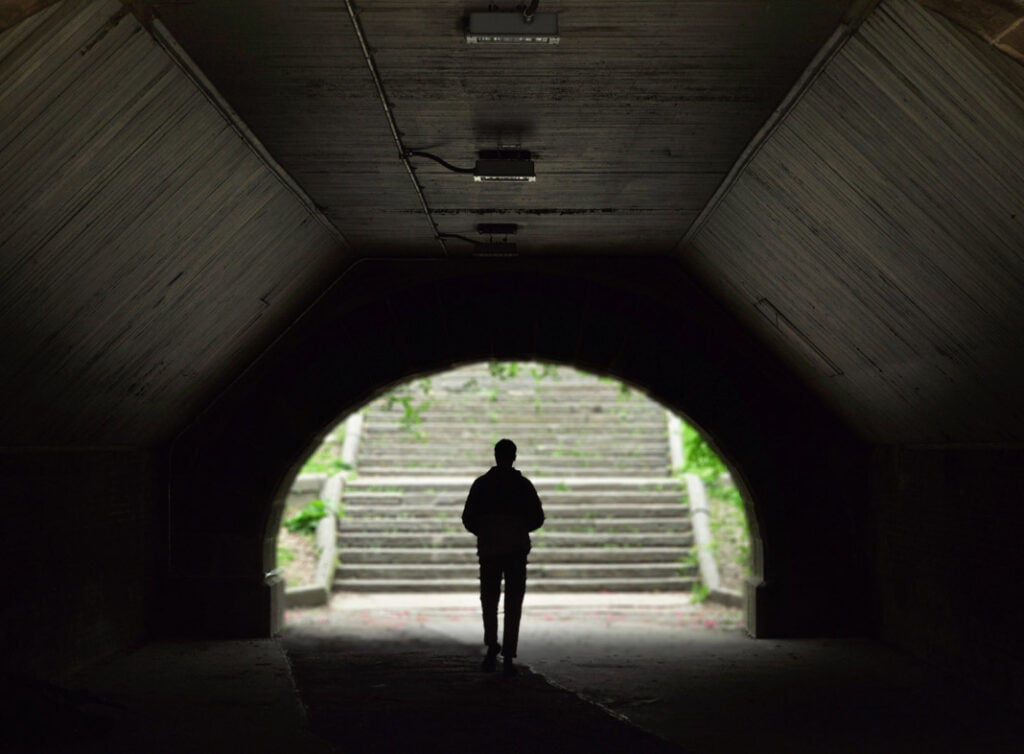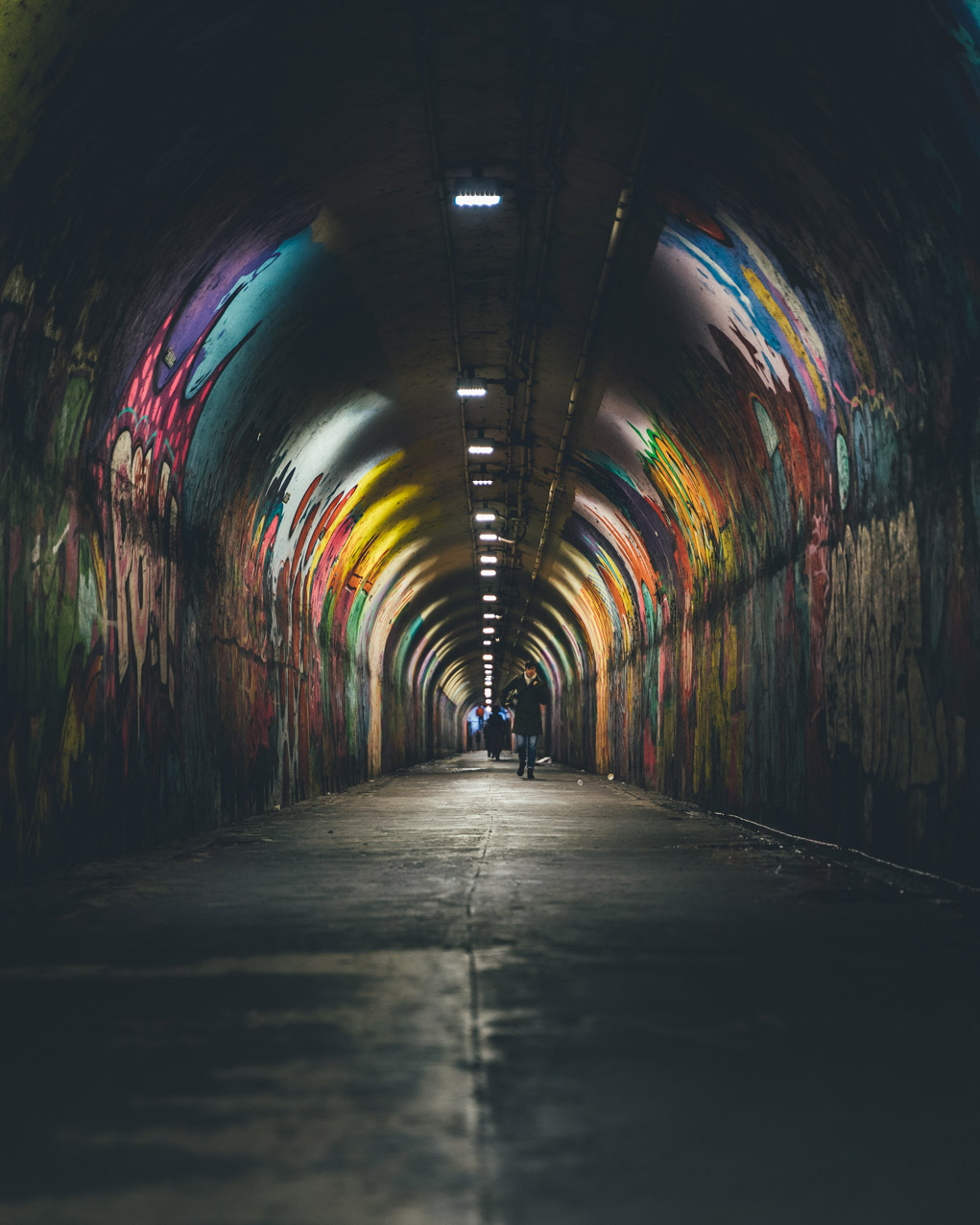Share this story


10 secret subway tunnels in New York City
There are hidden tunnels everywhere in NYC, and these are just 10 of the most fascinating
Just like the rest of New York City, our 115-year-old subway system consists of many layers, each of which provides a glimpse into a sliver of the city’s history. However, even abandoned underground spaces don’t stay neglected for long.
While some of NYC’s old tunnels and stations seem to have been neglected for good, many are reused—like the abandoned tunnel below Central Park that became part of the Second Avenue subway—and repurposed, as graffiti canvases, art galleries, party spaces, or even a VIP entrance to one of New York’s most luxurious hotels.
Read on for the history of 10 of the city’s most intriguing abandoned tunnels and stations.
Track 61, Grand Central Terminal
Track 61 is a special platform beneath the Waldorf-Astoria Hotel that allowed guests with private rail cars to have them routed straight to the hotel, where they could take a private freight elevator to enter the building. (Conveniently, the Waldorf was constructed directly above the tracks of the old New York Central Railroad, which connected the city to Chicago and the Midwest tracks.) Famous VIPs who used the entrance include World War I General John J. Pershing, who was the first to use the platform in 1938; President Franklin D. Roosevelt, who used the entrance to help conceal his paralysis from the public; and Andy Warhol, who held an "underground party" on the platform 1965. The street-level freight elevator entrance is still located at 101-121 East 49th Street.
- Open in Google Maps
:no_upscale()/cdn.vox-cdn.com/uploads/chorus_image/image/62998326/gct_track61.0.jpg)
Also featured in:
/cdn.vox-cdn.com/uploads/chorus_image/image/55664981/Guggenheim_Curbed_HIGH_Andrew_Pielage_18.6.jpg)
The most beautiful interiors in New York City, mapped
/cdn.vox-cdn.com/uploads/chorus_image/image/62603321/shutterstock_393727495.0.jpg)
The best holiday markets in NYC
Myrtle Avenue Tunnel
The Myrtle Avenue Station, part of the Fourth Avenue BMT line servicing the D and N between the Manhattan Bridge and DeKalb Avenue in Brooklyn, was closed in 1956 when the DeKalb station was rebuilt in order to reduce congestion. In 1980, artist and filmmaker Bill Brand used the station to create his own version of the zoetrope , an early stop-motion animation device. He installed 228 painted panels on one side of the abandoned platform and a slitted lightbox on the other to create Masstransiscope. Straphangers can see the 20-second "movie" today from northbound B or Q cars leaving DeKalb Avenue Station on the express track.
View this post on Instagram A post shared by Jay Ballesteros (@jayb.us) on Jul 3, 2018 at 6:25am PDT
Old City Hall subway station
City Hall was the first NYC subway station to open to the public in 1904, as part of the Interborough Rapid Transit (IRT) system, and was designed by architects George Lewis Heins and Christopher Grant LaFarge (who constructed the Cathedral of St. John the Divine). Rafael Guastavino (of Guastavino arch fame), and Gutzon Borglum (the sculptor who worked on Mount Rushmore, NBD), also worked on the station, which boasted spectacular arches, skylights, and even chandeliers. Service at the station was discontinued in 1945, when it was deemed impractical for lengthening by the IRT, and abandoned in favor of the nearby Brooklyn Bridge stop. Today, the New York Transit Museum offers tours of the station for its members, or you can catch a glimpse for free if you stay on the downtown 6 as it switches from the downtown to the uptown track.
:no_upscale()/cdn.vox-cdn.com/uploads/chorus_image/image/62998327/GettyImages_586120370.7.jpg)
Atlantic Avenue tunnel
Stretching for a half-mile from Columbia Street to Boerum Place in Cobble Hill, the Atlantic Avenue Tunnel claims the distinction of being the world's oldest subway tunnel—recognized by Guinness Book of World Records in 2010—and was once described by Walt Whitman as "a passage of Acheron-like solemnity and darkness." Originally constructed in 1844 to improve street congestion and safety issues, the tunnel was sealed in from 1861 until Brooklyn local Bob Diamond rediscovered it in 1981. Diamond ran tours of the tunnel for the public from 1982 until 2010, when the DOT abruptly canceled his contract of use. However, those looking to catch a glimpse of the tunnel can see the barrel-vaulted ceiling of the its alleged coal room at Brooklyn Heights speakeasy Le Boudoir , where parts of the tunnel have also been incorporated into the bathroom.
View this post on Instagram A post shared by Le Boudoir (@leboudoirbrooklyn) on Dec 13, 2018 at 4:00pm PST
East 18th Street subway station
The abandoned East 18th Street station was part of the first IRT subway system that opened in 1904 along the 6 line. The MTA closed the station when they started a platform extension program in 1948, and decided to lengthen platforms at 14th Street and 23rd Street instead. You can catch a brief glimpse of the station from the 6 (and the 4/5 if a local train isn’t passing by) between 14th and 23rd Streets. Though now, as Untapped Cities reports, the station is covered in graffiti, its original incarnation possessed a glass ceiling and decorative elements designed by Heins & LaFarge, who also designed the City Hall Station.
:no_upscale()/cdn.vox-cdn.com/uploads/chorus_image/image/62542535/18_Street_IRT_002.0.0.0.png)
South 4th Street subway station
This station was originally planned as part of the South Fourth Street Line, a key part of a 1929 plan that would have linked Williamsburg to Manhattan with two separate tunnels and four tracks beneath the East River. However, World War II halted the construction before track was ever laid. In October 2010, street artists Workhorse and PAC unveiled "The Underbelly Project," an expansive underground street art exhibition inside the station. According to the New York Times, which received an exclusive tour of the project, the exhibit displayed work from 103 street artists from around the world, who worked on their pieces during the night over the course of 18 months. Today the station has been abandoned once again, but a film on the Underbelly Project is coming sometime in 2019.
View this post on Instagram A post shared by Logan Hicks (@loganhicksny) on Oct 20, 2017 at 5:16am PDT
West 91st Street station
Located a few blocks from the 96th Street Station on the 1/2/3 line, the 91st Street Station was another casualty of platform extensions, closing in 1959 . You can see the station today while riding the 1 train, and the 2 or 3 if no other trains are in the way. In an illuminating 1999 New York Times article , writer Andre Aciman got to visit the station and observed: "The platform was filled with trash: broken beams, old cardboard and a litter of foam cups. This wasn't just the detritus of a subway station, but the leftovers of mole people."
View this post on Instagram A post shared by Tag Nation (@_tagnation_) on Dec 8, 2017 at 10:07am PST

Worth Street station
Located between Canal Street and Brooklyn Bridge on the original Interborough Rapid Transit (IRT) line—underneath the sidewalk on the west side of Foley Square—the Worth Street Station was closed in 1962 during the city's platform lengthening initiative (the Brooklyn Bridge station's platform was extended north instead). The station—and nearby Worth Street's —namesake was General William Jenkins Worth , a prominent leader in the Mexican War during the 1840s. People looking to pay homage to Worth today can visit his tomb at his Worth Square Monument at Broadway and 24th Street.
View this post on Instagram A post shared by Michael Alwill (@michaelalwill) on Sep 15, 2017 at 11:13am PDT
Nevins Street, lower level platform
The lower level of the Nevins Street station was initially constructed as part of a 1905 redesign of the IRT/Eastern Parkway line station, intended to allow connections on a Brooklyn-bound local track. Though track was never laid, the lower level was tiled, likely around 1918 , according to Joseph Brennan of Abandoned Stations. In 2016, artist Phil America used the abandoned platform as the site for an art installation condemning American gun violence. There are doors that lead to the unused platform in the underpass at the Nevins Street stop today.
:no_upscale()/cdn.vox-cdn.com/uploads/chorus_image/image/65481191/shutterstock_1400347685.0.jpg)
J/M/Z platform at Canal St
This platform was closed when the MTA decided to reconfigure the BMT Nassau Street Line in 2004. They took this eastern pair of tracks out of service, and re-opened the south end of the station so the northbound end of the track could run into the western platform. According to photos taken by the LTV Squad (a group of NYC urban explorers), there’s also an old subway entrance down there, with a 1990s-era token booth intact.
View this post on Instagram A post shared by Bad Guy Joe (@ltvsquad) on Jan 6, 2016 at 8:23am PST
Site search
- Los Angeles
- San Francisco
- Archive.curbed.com
- Homes for sale
- Homes for rent
- Neighborhoods
- Architecture
- Development
- Affordable Housing
- Transportation

- Search Experiences
- Manage Booking
- Phone # SMS #
- My Offers 5
Beneath the Surface: the Secret Tunnels Crisscrossing NYC

Featured in this post
Keep exploring.
New York, NY
Essential New York
Explore More
With its towering skyscrapers and historic high rises, New York City’s famous skyline naturally draws the eye upward. But what about what lies beneath the busy, bustling streets of the city that never sleeps?
In addition to the 665 miles of active subway tracks running beneath the city, the concrete hides an entire world of secret tunnels and subterranean spaces. If you dare to venture where the sun doesn’t shine, some of these hidden worlds are open to explore on guided tours.
Why does New York City have secret tunnels?
The thought that there could be hidden tunnels running right under your feet as you’re walking through Central Park is quite thrilling. But why does New York City have so many hidden tunnels?
There are a variety of reasons. Some are old subway tunnels or stations no longer in use, some were designed for freight trains passing through the city. Others, in the case of the 12th Avenue cow tunnels, were built to bring cargo—including cattle—into the city center without disrupting traffic. Some networks are used as utility tunnels for water, steam, and electrical lines. These tunnels are essential for maintaining the city’s infrastructure and are often out of public view. And others are used by law enforcement and emergency services for secure and rapid movement across the city.
During the Prohibition era (1920-1933), secret tunnels were often used for smuggling alcohol. Speakeasies and other illicit operations used these tunnels to transport booze and avoid law enforcement. Some were never completed at the onset of World War II, while others were sealed off due to progress or changes.
Finally, during the Cold War, secret bunkers and tunnels were constructed for use in the event of a nuclear attack. These were intended to protect government officials and essential personnel.But they’re still there, hidden beneath the surface, waiting to be discovered.
The coolest tunnels and underground places in NYC
Over the course of nearly 400 years of history, this constantly evolving city has seen buildings and tunnels come and go, but these subterranean spaces have survived the test of time.

1. Basilica of St. Patrick’s Old Cathedral Catacombs
Located beneath the 200-year-old Basilica of St. Patrick’s Old Cathedral in SoHo, you’ll find some of the only catacombs in Manhattan. Off-limits to the public except on special guided tours, these historic catacombs are the final resting place for many NYC luminaries and key figures.
2. City Hall subway station
Built in 1904, the City Hall subway station once acted as the southern terminus of NYC’s first subway line. It closed in 1945 due to its proximity to the larger Brooklyn Bridge station, but its spectacular arches and elegant design can still be seen on tours operated by the New York Transit Museum .
3. Worth Street subway station
This now-disused station was part of NYC’s first subway system before the Brooklyn Bridge station rendered it worthless. While not one of the most popular abandoned stations, urban explorers enjoy venturing there to see the graffiti-covered tiles and mosaics.

4. Freedom Tunnel
Lovers of street art flock to this abandoned freight-train tunnel under Riverside Park. After it went out of use in the 1980s, graffiti artists and others used the blank walls as a canvas, giving rise to an eclectic underground gallery.
5. Atlantic Avenue tunnel
Also known as the Cobble Hill tunnel, the half-mile Atlantic Avenue tunnel is not only the oldest subway tunnel in NYC but also the world. Running beneath Brooklyn’s Atlantic Avenue, it was first built in 1844 and was sealed off in 1861. Although it’s still closed, you can see part of the historic structure in the underground speakeasy Le Boudoir , which borders the tunnel.
6. Grand Central Terminal’s blocked-off tunnels
Obviously, Grand Central Terminal itself is no secret. But once you dive into its history, you’ll find that there are numerous disused tunnels connected to the terminal.
Some of these underground tunnels were constructed in the early 1900s as part of a project, called Terminal City, that connected the station to nearby hotels, like the Waldorf Astoria and its famous Track 61 abandoned tunnel. You can learn more about the history of Grand Central Terminal on the Official Grand Central Terminal Tour .
7. Other cool tunnels under NYC
There are scores of other intriguing hidden tunnels under NYC, including the Farley Morgan Postal Tunnel, the Myrtle Avenue Tunnel, and the McCarren Park Pool Tunnels.

How to discover secret NYC tunnels
Many of the disused subway stations and tunnels running under NYC are closed to the public for safety reasons, but there are still ways to see them. In some cases, you can catch glimpses of disused subway tunnels or subway platforms while riding past on currently operating lines. Others, like the City Hall station, can be explored on exclusive guided tours.
See a different, darker side of NYC in its secret tunnels
By venturing underground to explore hidden tunnels and spooky catacombs, you’ll experience a side of New York that few get to see. Just be sure to explore above ground too—our Walks tours celebrate the city in all its glory.
Original Post Date: October 26, 2022
Be the first to get offers and news
Shopping cart, find your experience.

IMAGES
VIDEO
COMMENTS
On this guided New York subway walking tour you will discover the fascinating beginnings of the New York City subway, and explore spaces even the most seasoned commuter might not...
There are hidden tunnels everywhere in NYC, and these are just 10 of the most fascinating. By Lauren Vespoli Updated Oct 16, 2019, 1:18pm EDT. The old City Hall subway stop, which opened in...
Underground Subway Art Tour - Untapped New York Tours. Book Now. 2 hours. $29 to $39. Up to 15 guests. Flexible Cancellations. Tour Highlights. Enter the world’s largest underground public art...
Take an underground trip through New York City history on this walking tour of the subway system. Your guide will describe the origins and lore of the city's underground transit while showing you overlooked corners, hidden art installations, and remnants of lost architectural wonders.
Learn the secrets of New York’s subway on a 2.5-hour underground tour with a private guide. Hear stories about the engineering, technology and people behind the subway’s construction. Discover legends and secrets about abandoned levels, hidden stations and fake houses that disguise escape routes around the city.
In some cases, you can catch glimpses of disused subway tunnels or subway platforms while riding past on currently operating lines. Others, like the City Hall station, can be explored on exclusive guided tours. See a different, darker side of NYC in its secret tunnels